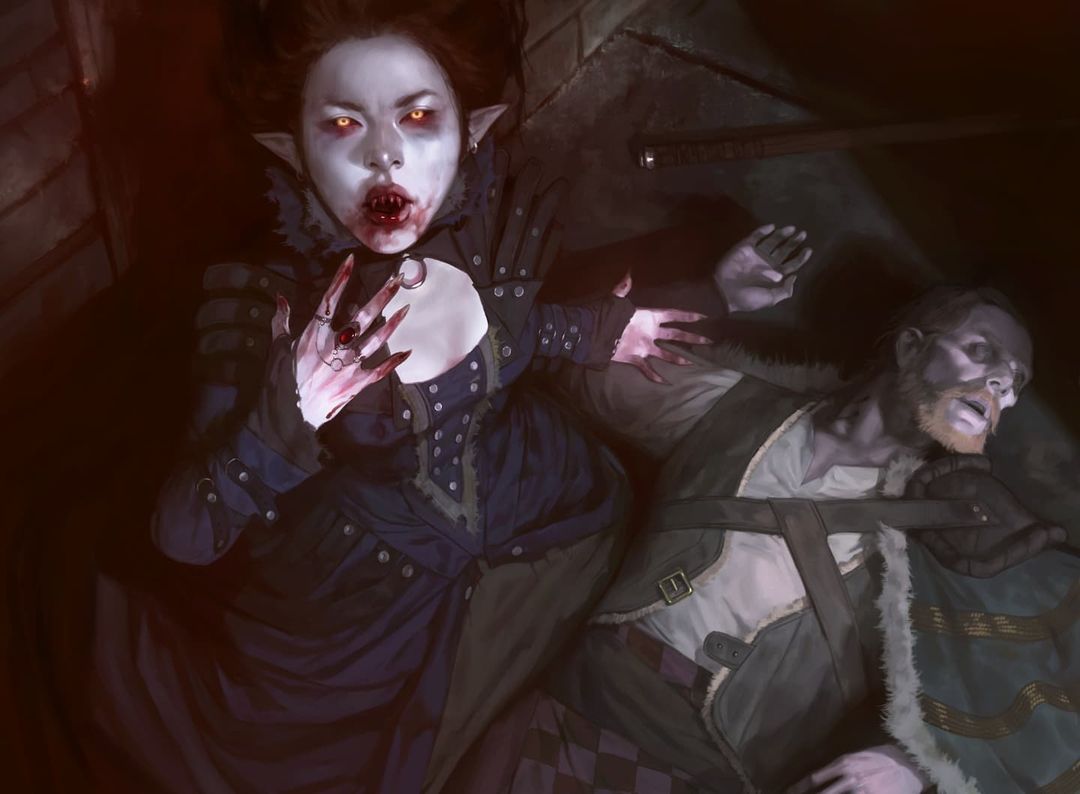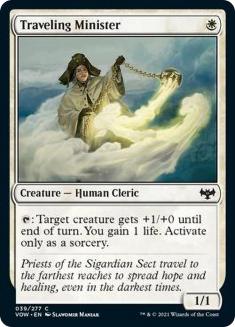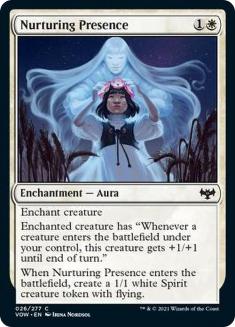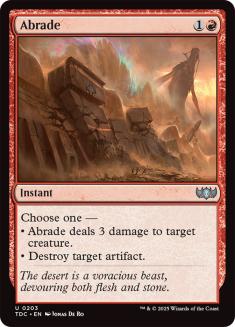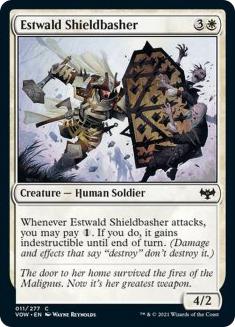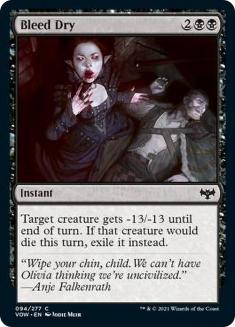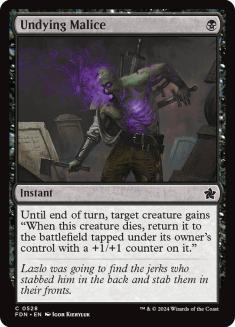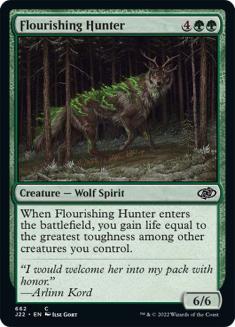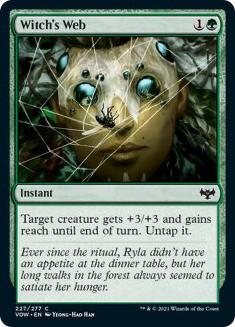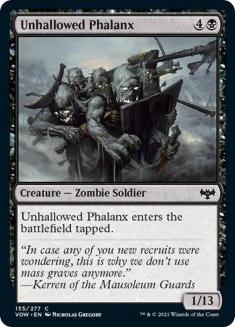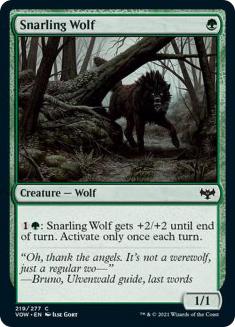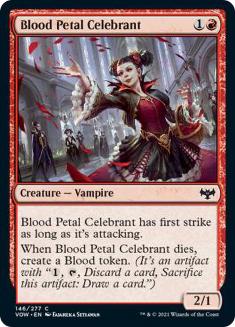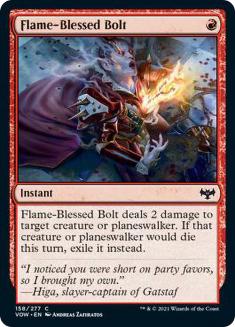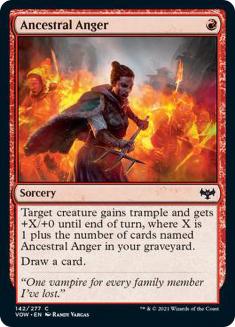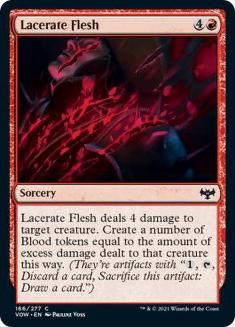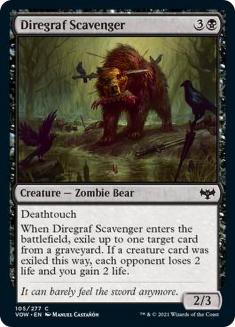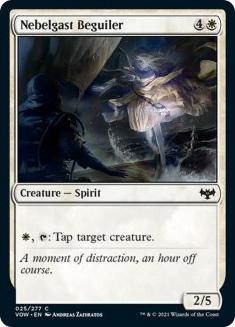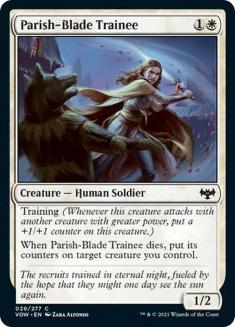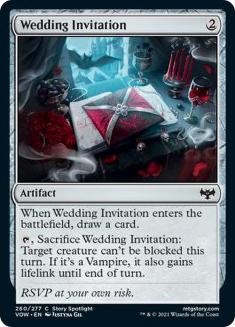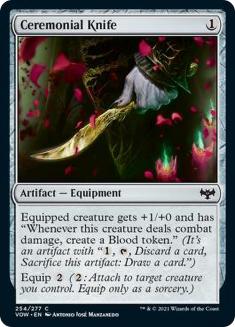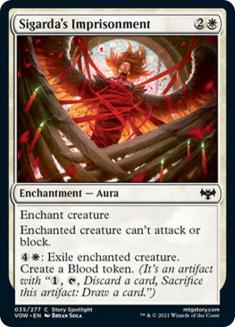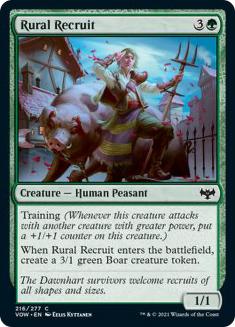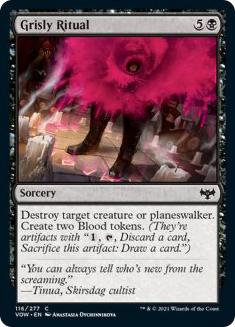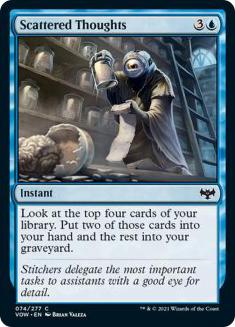Now that Thanksgiving/National Day of Mourning, is over, I hope you also had a chance to see your family for a few minutes, then ducked off somewhere to draft. If you’re not spending a national holiday drafting four-color Hullbreaker Horror, what are you even doing? Draft is a hell of a drug. I even got a couple of games in before my flight back from Vegas.
It’s been two weeks since the digital release of Innistrad: Crimson Vow and I finally have some data to get my grindy little hands on. Thanks to 17Lands, we no longer have to rely on grades to be our guide to the new format. Predicting things is hard; that’s why meteorologists make the big bucks and get cool fake names like Dallas Raines.
Today, I’m breaking down each of the main archetypes. What’s on the menu? What commons are the stuffing and mashed potatoes? Which ones are the yams?
Azorius
It’s all disturb, all the time. Trade your creatures early, reap the rewards down the road. The deck plays faster than you’d imagine and then closes the game with its evasive threats, protecting them in myriad ways.
Best Common: Traveling Minister
It’s the golden age of one-drops, everyone, and Traveling Minister is preaching the gospel. Buffing your creatures for free always feels like you’re getting away with something, but gaining life while doing it is a downright steal. It makes every creature you cast better while helping you win any race. The best decks are playing upwards of four, as the data doesn’t hate drawing them late: 17Lands IWD (Win Rate Improvement When Drawn) is a net 5.4 percentage points higher than never drawing them.
Best Common You’re Not Drafting Highly Enough: Nurturing Presence
The second-best common is an Aura. You read that right. Creating a 1/1 flyer when Nurturing Presence sticks (and the immediate trigger) is the key here, as your Ministers love an evasive target to hit. Enough enchantments-matter cards are floating around you don’t mind jamming bonus Auras that aren’t your disturb creatures. Tip: avoid the temptation to toss one on your Traveling Minister Turn 2, but I love slapping it on a Lantern Bearer and going to work.
Stop Playing: Piercing Light
In a format that values cheap interaction, it feels wild to call out Piercing Light. Azorius is actively trying to trade its cheap disturb creatures and get value later from the back half, so don’t waste a card on mediocre removal that doesn’t hit some of the best creatures in the format. You know, like that Minister we were just talking about.
Boros
Skip leg day (and training), focusing obsessively on your curve instead. Keep it low and tight, eschewing expensive removal and creatures for speed. With no payoffs at common for going wide, you’re counting on efficiency from top to bottom.
Best Common: Abrade
Three damage at instant speed turns out to be a deal in this Limited format, where Abrade kills almost 71% of creatures. Boros wants to clear the path early for aggressive creatures while building out its battlefield, making this ideal removal. In a pinch, you can even snap off a Blood token. 99% of the time, that’s the wrong decision, but I can’t stop you.
Best Common You’re Not Drafting Highly Enough: Falkenrath Celebrants
I get visibly upset when I see Falkenrath Celebrants going as late as they have been. A Top 5 Boros common, these party animals are going a full pick later than much worse cards like Drogskol Infantry and Gryff Rider. Ideally, this is the top of your curve, and you can pitch lands into your graveyard for the rest of your life. Menace also plays quite well with the only combat tricks you’re happy to run here in Sure Strike.
Stop Playing: Estwald Shieldbasher
I know it seems like a solid training enabler, but Estwald Shieldbasher is too vulnerable to cheap removal to justify four mana. We’re not even sure if training is a viable mechanic. You’ll see games where this plays out okay and you’ll think, “Old Uncle Cardboard lied to me.” Decks that play this card and don’t draw it win 5% more games, comparable to other flotsam like Unholy Officiant.
Dimir
Exploit, and nothing else. The biggest mistake I see is people trying to add Blood or lifegain packages to their Dimir decks. You’ll win more when you stick to the script: a highly synergistic and linear deck that casts creatures to exploit and creatures to do the exploiting. Counters and removal fill out your 40.
Best Common: Bleed Dry
No surprise here, as Bleed Dry is a beater that answers anything in the format not named Avabruck Caretaker. However, an honorable mention must go out to our #2 in Diregraf Scavenger, a card that continues to outperform meager expectations. Graveyard interaction that swings four points of life and has a decent deathtouch body turns out to be solid. It’s like cheese being the best form of dairy: you can’t argue with it.
Best Common You’re Not Drafting Highly Enough: Undying Malice
The data is higher than I would have expected on Undying Malice, rating it as the eighth-best common and third-best spell, just 0.2% behind Chill of the Grave. Obviously, you have a ton of enters-the-battlefield effects in decks with exploit, but there’s also the old gem of exploiting a creature to itself and casting Malice in response. I don’t think you have to go too overboard with these, but I don’t mind two in a focused, linear deck.
Stop Playing: Selhoff Entomber
*In my best annoying manager voice*
Way too many Selhoff Entombers making it into the 40, people. Gotta tighten it up. R&D, I’m looking at you. This deck doesn’t care about disturb, so while you may think it’s cute to get extra value out of a Persistent Specimen, it’s not. Heck, it’s middling in the deck that does care about disturb. Looting only creature cards away is a significant drawback.
Golgari
Be midrangey and don’t worry about the size of your butt, Becky. The toughness deck is fine if you wind up in it, but it’s not a requirement for Golgari to perform. Rather, it’s a value-based deck that wants to answer threats efficiently and play big beaters at the top of its curve.
Best Common: Flourishing Hunter
Unseating Bleed Dry’s reign at the top is Flourishing Hunter, a reward for playing the biggest butts you can while helping stabilize against faster decks. Am I taking it over Bleed Dry? Absolutely not. I don’t think even the auto-drafter could mess that up. What I do think it represents is great value, as its ATA (Average Taken At) shows it’s being drafted pick 7.42. Also, shout-out to the first week of the format where I didn’t realize it was “other creatures” and kept thinking Arena was bugged. Reading is hard.
Best Common You’re Not Drafting Highly Enough: Witch’s Web
Your second-best common is Witch’s Web, a wild sentence that I’m still currently typing in awe. With three and four coming in as Bleed Dry and Grisly Ritual, this combat trick is really playing out as a secret fight spell that helps you deal with opposing flyers. This deck is absolutely rotten against things with wings, while +3/+3 isn’t a bad stat line for two mana.
Stop Playing: Unhallowed Phalanx
More meme than dream, Unhallowed Phalanx can’t even crack the Top 30 in a color pair that was supposed to be emphasizing toughness. Let’s break down why: it’s very expensive, enters tapped, and still dies to most non-damage-based removal. Nevertheless, people have still played it over 1,000 games more than Rural Recruit or Witch’s Web, cards that own it by the numbers.
Gruul
Cast your giant Werewolves and turn them sideways. Gruul isn’t forging any new territory here, but it doesn’t need to and neither do you. Be prepared to diligently manage day/night and hope for one of the many bombs like Halana and Alena, Partners.
Best Common: Abrade
Gruul is trying to do the opposite of Boros and survive until it can get a Hookhand Mariner, Flourishing Hunter, or Falkenrath Celebrants on the battlefield. So how do you stay alive? Cheap removal like Abrade and Flame-Blessed Bolt, your #1 and #2 respectively. Killing things is good. News at 11.
Best Common You’re Not Drafting Highly Enough: Snarling Wolf
In a world where you’re handsomely rewarded for letting day turn to night, Snarling Wolf isn’t the worst way to spend the mana you’re leaving up. A bust in Innistrad: Midnight Hunt, the Wolf is enjoying a renaissance in this format and can help keep you alive until its bigger siblings hit the battlefield. With an ATA of 9.99, it’s available later than a Taco Bell drive-thru. I can’t resist the value of either.
Stop Playing: Blood Petal Celebrant
If you don’t have Blood Petal Celebrant in your opening hand, it’s worse than drawing all but five other red or green cards. There’s no reason it should be more played than Witch’s Web or Lightning Wolf thus far. Your early creatures should almost always be Wolves or Spore Crawler, as you care about synergy over a random Blood token it needs to die to give you.
Izzet
Spells kind of matter, but not like we’re used to. This deck reminds me somewhat of the Slither Blade deck that was good for a week in Amonkhet. You leverage cheap creatures and spells no one wants to get in for heaps of early damage. Your biggest priority is amassing interaction for three mana or less, leaving your opponent on their back foot while you dump more small creatures.
Best Common: Flame-Blessed Bolt
We’ve talked enough about instant-speed damage, so I’m using this space to give a shout-out to #2: Voldaren Epicure. The Kirkland-brand Thraben Inspector is exactly what this hyper-aggressive deck is looking for by chipping in for a little damage and leaving behind a Blood token. Later, you can sacrifice it to a random exploit creature or chump a big attacker while you race. I’ve been very high on this deck when not facing Traveling Minister.
Best Common You’re Not Drafting Highly Enough: Ancestral Anger
Epicure clearly qualifies, but let’s find some payoffs for it in Ancestral Anger, a card being taken at Pick 10.78 on average. Wheeling enough of these makes for a long day for your opponents. You wind up with enough incidental Blood that it’s easy to cycle lands drawn off this cantrip. Trample sometimes ends things when your opponent thinks they have bought themselves some time. Step into the rage cage with me, friends.
Stop Playing: Lacerate Flesh
I don’t expect anyone to listen to me, but Lacerate Flesh is pretty bad in this deck. For starters, it’s very expensive for four damage at sorcery speed. You’d rather be playing faster and more disruptively with cards like Alchemist’s Retrieval and Chill of the Grave. You’re also not generating Blood often enough to justify the expense. There also aren’t the typical ways to reduce spell costs or noncreature mana generators, so you’re left paying full price all the time. For that reason, I’m out.
Orzhov
Gain enough life to win in the air. This deck is what we thought it was, netting you tons of life through a highly synergistic combination of creatures. If you’re new to the format, Orzhov is a great place to start as a straightforward lifegain-matters option.
Best Common: Diregraf Scavenger
Even better here than in Dimir, Diregraf Scavenger’s incidental lifegain plays great alongside cards like Markov Purifier or Heron of Hope. It also helps mitigate the life you lose from the second-best overall common: Pointed Discussion. Did I just sneak that in here to blow your mind? Guilty as charged. This is a grindy deck that needs card advantage and would love access to a little Blood, too. PD checks all the boxes.
Best Common You’re Not Drafting Highly Enough: Nebelgast Beguiler
If you follow me on Twitter, you’ve heard me ranting about Nebelgast Beguiler for a while now and would probably prefer me shutting up, frankly. Nebby ranks out higher than so many cards people love — Blood Fountain, Grisly Ritual, and Desperate Farmer to name a few — yet is still going around Pick 11. Five toughness is the real deal in this format, and while it’s expensive, the tapping is available for the low, low cost of one white mana. What usually happens is it makes attacks very awkward and you get to tap something at the end of your turn to do work.
Stop Drafting: Parish-Blade Trainee
I did a double-take when I saw nearly 9,000 of these have been played in Orzhov. This deck is starving for two-drops, but you’d rather play Ragged Recluse or Drogskol Infantry first. Make them a priority during your drafts so you’re not stuck with PBT (or Pretty Bad ‘Ttacker).
Rakdos
Play Vampires, generate Blood tokens, and dominate. The runaway best deck in the format so far, Rakdos can generate pressure early while sacrificing incidental tokens it accumulates along the way to never run out of threats. Vampires don’t get many significant payoffs, but you’re not hurting for them, either.
Best Common: Bleed Dry
Checks out. The next two up are Abrade and Flame-Blessed Bolt. Moving on.
Best Common You’re Not Drafting Highly Enough: Wedding Invitation
I haven’t personally played with Wedding Invitation and therefore I’m nervous advising anyone to do so. The sample size isn’t insignificant, though, with over 6,000 players casting it. Worst-case scenario? It cycles. The best case is that you get to go straight to the face in an aggressive deck. No one minds gaining some life off their Vampires, but that’s just upside in a race.
Stop Playing: Ceremonial Knife
Don’t cut me over this, but Ceremonial Knife is a huge bust thus far by the numbers. Maybe data can’t appreciate the value of Blood tokens, but a -10% IWD is epically bad. The equip cost can be cumbersome in a deck that would love to be pitching lands to Blood tokens, but two colorless isn’t that egregious. Broadly, I haven’t struggled to generate Blood so far in the format, so perhaps the Knife falls on the side of being “extra” in Rakdos and more at home in a deck like Simic.
Selesnya
Play good creatures, preferably Humans? Training hasn’t come together thus far, so you’re a traditional Selesnya Good Stuff deck. Humans isn’t very well supported in terms of payoffs, so add counters to creatures and turn them sideways.
Best Common: Sigarda’s Imprisonment
With exploit looking hype-worthy during preview season, Sigarda’s Imprisonment was viewed as potentially sus removal. Dimir has stumbled out of the gates, however, and exiling a threat plus generating Blood in a color that struggles mightily to do so isn’t that bad of a deal after all. Selesnya struggles to interact with opposing threats, so this is firmly a must-play.
Best Common You’re Not Drafting Highly Enough: Rural Recruit
I know it’s not incredibly exciting, but Rural Recruit is still going a few picks later than its win rate indicates. You’re happy to get a couple of bodies when removal is as clunky as it is, especially one coming in as an occasionally relevant creature as a Human. Recruit is rolls at Thanksgiving: empty carbs you shouldn’t pass up.
Stop Playing: Estwald Shieldbasher
… for all the same reasons as before. The data puts this card right around Moldgraf Millipede and Unholy Officiant, yet it’s been played almost 10,000 times to their 2,671 and 1,909 respectively.
Simic
The signpost uncommon lied. Simic doesn’t do self-mill well, instead playing best as a flash-without-flash deck. Ideally, you get a Werewolf on the battlefield and protect it with counterspells. Since you’re holding mana up, you’re the beneficiary of more nights than days.
Best Common: Grisly Ritual / Abrade
Kind of tells you what you need to know in terms of how great Simic is at interacting with opposing creatures, right? I’m partial to a Grisly Ritual at the top-end so you have more time to draw your splash and cash in those Blood tokens. Abrade is serviceable and you’re not mad at having one. Prioritize Evolving Wilds, Weaver of Blossoms, or Reclusive Taxidermist to make it work without punishing your manabase too much.
Best Common You’re Not Drafting Highly Enough: Scattered Thoughts
I consider Scattered Thoughts the engine of strong Simic decks that are staying on plan of having something worth spending mana on at instant speed. You’re not getting full value out of the cards that go to the graveyard in most cases, but when a Lantern Bearer goes by the wayside, you’re pulling ahead. An honorable mention goes to Cradle of Safety, protector of Werewolves everywhere.
Stop Playing: Mulch
With the self-mill deck never coming together, you struggle to find ways to generate value out of your graveyard. The disturb cards in blue feel worse on balance than their white counterparts. The play pattern of someone Mulching on Turn 2 and then having to discard a land or two when they hit never feels great. There’s a reason it’s the seventh-worst common.
Overall, I think Innistrad: Crimson Vow has received a bad rap for being a “bomb-heavy” format when, in all reality, we’re just scratching the surface on what decks want to do. It looks like there are quite a few aggressive archetypes to tool around with that can get under those Hullbreaker Horrors and Toxrill, the Corrosives of the world.
As always, I’ll see you in the queue.

